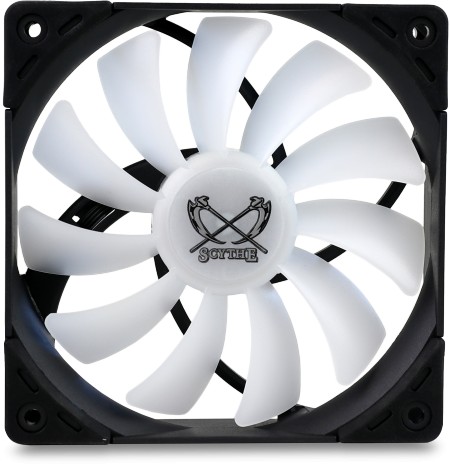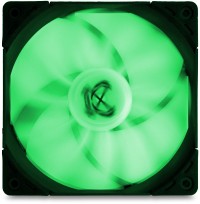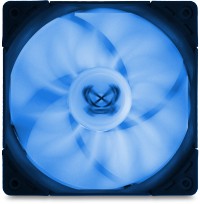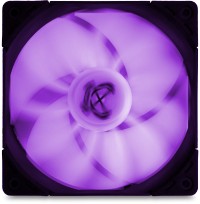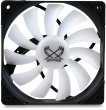Kaze Flex 120mm 3-pin RGB 1200 RPM Case Fan NZ$ 17.60 (was NZ$ 20.79) Save 15% 11 in stock | ||
| More variations available Show | ||
Scythe Kaze Flex 120mm 3-pin RGB 1200 RPM Case Fan
The Kaze Flex fan series combines the award-winning technology of the Kaze Flex fan with an optical revision and RGB LED lighting.
Features
- Quiet PC cooling fan
- Closed Fluid Bearings
- Eight RGB LEDs
- 24.9 dB(A) / 1200 RPM / 51.2 CFM
- MTBF 120,000 hours
The all-black frame and decouplers, highlight the translucent fan blades illuminated by eight LEDs. A standard 4-pin RGB connector allows control by a number of different RGB motherboard controllers. Thanks to a bush that has been ground through, several fans can be connected in series. The outstanding performance data of the Kaze Flex series remain untouched. The Sealed Precision FDB bearings ensure a service life of over 120,000 hours.
RGB LED lighting
Eight RGB LEDs arranged in a ring around the fan motor generate consistent and powerful illumination via the translucent fan blades. The LEDs are operated via a standard 4-pin RGB cable that is designed to connect to various mainboard manufacturers, for example, ASUS Aura Sync, ASRock RGB LED, MSI TM Mystic Light Sync and Gigabyte RGB Fusion are all compatible.
Sealed Precision FDB
The Kaze Flex range of fans uses a Sealed Precision FDB to ensure smoother running and longer life. The bearings and spindle are made entirely of high-quality, compressed metal and lubricated by a special, up to 250°C resistant oil film. This dramatically reduces friction for smooth running and reduced wear, resulting in an average life of 120,000 hours.
Integrated decouplers
The Kaze Flex fan series has been fitted with vibration and shock absorbing rubber pads on the tunnel-less screw holes. These decouplers effectively prevent the transmission of any vibrations and contribute to a quiet operation.
Equipment
The Kaze Flex 120 RGB fans are each equipped with a 50cm sleeved connection cable and a 4-pin RGB cable with an additional, ground-through plug. The fan also has an adapter for direct connection to a power supply.
| Specifications | Kama FLEX 1200 3-pin |
|---|---|
| Model | SU1225FD12MR-RH |
| Size | 120x120x25 mm |
| Airflow | 51.2 CFM |
| Noise Level | 24.9 dBA |
| Rotational Speed (±10%) | 1200 RPM |
| Static pressure | 1.05 mm H2O |
| Approximate cable length, cm | 50 |
| Life expectancy @ 25°C continuous use | 120,000 hours |
| Amperage | 0.13 A |
| Amperage LEDs | 0.40 A |
| Connector | 3-pin |
| Power consumption | 1.56 W |
| Bearing type | Closed fluid bearings |
| Mounting hardware included | Screws |
| Accessories | 3 to 4-pin Molex adapter, 4x screws |
| Voltage | 12 V |
| RGB | Yes |
| Warranty | 24 months |
| EAN barcode | 4571225056876 |
| Specifications | Kama FLEX 1200 3-pin |
|---|---|
| Model | SU1225FD12MR-RH |
| Size | 120x120x25 mm |
| Airflow | 51.2 CFM |
| Noise Level | 24.9 dBA |
| Rotational Speed (±10%) | 1200 RPM |
| Static pressure | 1.05 mm H2O |
| Approximate cable length, cm | 50 |
| Life expectancy @ 25°C continuous use | 120,000 hours |
| Amperage | 0.13 A |
| Amperage LEDs | 0.40 A |
| Connector | 3-pin |
| Power consumption | 1.56 W |
| Bearing type | Closed fluid bearings |
| Mounting hardware included | Screws |
| Accessories | 3 to 4-pin Molex adapter, 4x screws |
| Voltage | 12 V |
| RGB | Yes |
| Warranty | 24 months |
| EAN barcode | 4571225056876 |
Product Resources
FAQ
How do I measure fan size?
The size of fan you need will generally be determined by the size of the fan fitting position in your PC case. The sizes of all the fans on our website are shown as measured along any one of the fan’s four sides, NOT the distance between the fan’s screw holes! Our most popular fan size is 120mm, followed by 80mm. This isn’t really dictated by customer preference, but more by recent designs of PC cases.
As for the thickness (depth) of the fan, generally 25mm (1 inch) is by far the most common depth, although smaller fans can have shallower depths such as 15mm or even 10mm. All our fans are 25mm thick unless otherwise stated. If you have any questions about which fan you should order, please don’t hesitate to get in touch.
If you know the distance between the fan mounting screw holes but don’t know what fan size to order, please see the following table. Note that the mounting hole measurements shown below are taken horizontally or vertically between the holes and not diagonally.
Screw hole spacings and fan sizes
Space Between Screw Holes Fan Size 32mm 40mm 40mm 50mm 50mm 60mm 60mm 70mm 72mm 80mm 83mm 92mm 105mm 120mm I received a small cable (resistor) with my fan; what is it for?
The resistor cable (also called Ultra Low Noise or ULN cable) is designed to allow the fan to run slightly slower for even quieter operation. The benefit in lower running noise is significant. Although the airflow will be reduced slightly, this usually has minimal effect on PC temperature. We would generally recommend using the ULN resistor cable for best results in almost all circumstances.
How can I tell which way the air blows through the fan?
Hold the fan so that the round fan sticker is facing you. You are looking at the rear of the fan. When you plug the fan in, the air will be blowing towards you. If you want a fan to act as an air intake, then the fan sticker will be facing the inside of the case. Some fans also have two small arrows moulded into their plastic housing - one arrow shows the direction of airflow, and the other (at 90°) shows the direction of blade rotation.
Is it possible to use a 4-pin PWM fan or CPU cooler with a motherboard which has only 3-pin fan headers on it?
Electrically, there is no problem doing this - the fourth pin on the fan cable is used purely for PWM control and is not needed in order for the fan to run. So you can plug the 4-pin fan connector onto the 3-pin motherboard fan header, leaving the fourth pin not connected to anything. The fan will potentially run at full speed, so if you would like to reduce the speed of the fan you will need to adjust the fan speed setting in your BIOS or use fan control software such as SpeedFan in Windows.
The only other problem to consider is that occasionally, components immediately adjacent to the motherboard fan header can get in the way of the larger 4-pin fan connector, physically preventing connection. This problem also occurs if you try to use an in-line fan speed controller such as the one made by Gelid.
Another avenue to explore is the possibility of using a bay-mounted fan controller. Several models are available now which provide 4-pin fan headers, so this is an easy way to use 4-pin PWM fans in a PC system which has only 3-pin fan headers on its motherboards. When using this method, you may find it necessary to disable any fan warning settings in your motherboard BIOS, since the motherboard may incorrectly believe that its CPU fan has failed when the fan is connected to a fan controller rather than directly to the motherboard itself.
Top Quiet Fans

Noctua NF-A20 PWM 5V 800RPM 200x30mm Extra Large Quiet Fan

Noctua NF-A12x25 PWM chromax.black.swap 12V 2000RPM 120mm Fan

Noctua NF-S12B REDUX 12V 700RPM 120mm Quiet Case Fan

Noctua NF-A6x25 PWM 12V 3000RPM 60x25mm Low Noise Fan
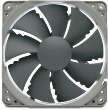
Noctua NF-P12 REDUX PWM 12V 1700RPM 120mm Quiet Case Fan
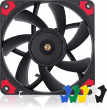
Noctua NF-A12x15 PWM chromax.black.swap 12V 1850RPM 120x15mm Fan

Noctua NF-A14 PWM chromax.black.swap 12V 1500RPM 140mm Fan

Noctua NF-F12 iPPC PWM 12V 3000RPM 120mm High Performance Fan

Noctua NF-A14 PWM 12V 1500RPM 140mm Premium Quality Fan
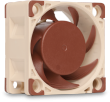
Noctua NF-A4x20 PWM 12V 5000RPM 40x20mm Quiet Cooling Fan

